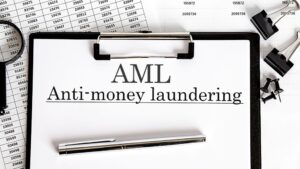AML Training for Senior Management
When it comes to combating financial crime and ensuring compliance with anti-money laundering (AML) regulations, providing AML training for top-level executives is of utmost importance. The board of directors, the CEO, and other senior management play a critical role in setting the “tone at the top” and establishing a culture of compliance within the organization (Financial Crime Academy).
Importance of AML Training for Top-Level Executives
Top-level executives need to understand the significance of AML compliance and their role in upholding it. AML training equips them with the knowledge and skills necessary to effectively lead their teams in combating financial crime. By understanding the intricacies of money laundering and the potential risks associated with non-compliance, executives can make informed decisions and provide guidance to their subordinates (Financial Crime Academy).
By receiving comprehensive AML training, top-level executives gain awareness of the regulatory landscape and their obligations. They become familiar with the red flags and indicators of money laundering, enabling them to identify suspicious activities and take appropriate actions. AML training empowers executives to create a culture of compliance within their organizations, fostering an environment where AML controls are prioritized and integrated into daily operations.
Role of Top-Level Management in AML Compliance
Top-level management plays a crucial role in driving AML compliance throughout the organization. They are responsible for establishing policies, procedures, and control frameworks that promote effective AML controls. By setting clear expectations and demonstrating a commitment to compliance, executives create a strong foundation for a culture of integrity and ethical behavior.
Furthermore, senior management is responsible for allocating resources and ensuring that adequate systems and processes are in place to prevent, detect, and report potential money laundering activities. They provide oversight and guidance to compliance teams, ensuring that AML programs are implemented effectively and continuously improved upon.
To effectively fulfill their role in AML compliance, top-level executives must stay abreast of evolving regulations and emerging financial crime trends. AML training equips them with the knowledge and understanding necessary to navigate the complex and ever-changing landscape of AML regulations. By participating in ongoing training and education, executives can lead their organizations with confidence and ensure that AML controls are robust and effective.
In conclusion, providing AML training for top-level management is crucial in establishing a strong culture of compliance and combating financial crime. By understanding the importance of AML compliance and their role in it, executives can effectively lead their organizations in mitigating money laundering risks and ensuring regulatory compliance. Ongoing training and education are essential to keep executives informed and equipped to address the evolving challenges of financial crime.
Key Topics in AML Training for Senior Management
To ensure effective anti-money laundering (AML) controls within an organization, it is crucial for top-level management to receive comprehensive AML training. This training should cover key topics that provide a strong foundation of knowledge and understanding. Here are three essential areas to focus on when conducting AML training for senior management:
Regulatory Requirements and Obligations
Senior management must comprehend the regulatory landscape and their obligations to establish and maintain effective AML controls within the organization. AML training for top-level management should include an in-depth exploration of relevant regulatory requirements and obligations. This includes understanding key laws and regulations such as the Bank Secrecy Act (BSA) and the USA PATRIOT Act in the United States, as well as international AML regulations like the Sixth EU Anti-Money Laundering Directive, the Wolfsberg Anti-Money Laundering Principles, and the Financial Action Task Force (FATF) Recommendations (Financial Crime Academy).
Understanding the regulatory framework enables senior management to effectively oversee AML compliance efforts, implement necessary policies and procedures, and ensure the organization’s adherence to applicable laws and regulations.
Understanding Money Laundering Risks
AML training for senior management should provide a comprehensive understanding of the risks associated with money laundering. This includes recognizing the red flags and indicators of potential money laundering activities. By understanding the techniques and methods employed by money launderers, top-level management can better identify and mitigate these risks within their organization.
The training should cover various money laundering typologies, such as structuring, smurfing, trade-based laundering, and virtual currency-related offenses. Additionally, it should address emerging risks, such as those associated with new technologies like cryptocurrencies and blockchain, which can be exploited for money laundering purposes (Financial Crime Academy).
Establishing a Culture of Compliance
A strong culture of compliance is crucial for effective AML practices throughout an organization. Senior management plays a pivotal role in setting the tone of compliance and ensuring that it permeates every level of the organization. AML training should emphasize the importance of establishing and nurturing a culture of compliance.
Topics to cover include the role of senior management in promoting ethical behavior, the importance of leading by example, and the establishment of clear policies and procedures that support AML compliance. This training should emphasize the responsibility of senior management to communicate and reinforce the organization’s commitment to AML compliance throughout the workforce.
By focusing on these key topics in AML training for senior management, organizations can equip their top-level executives with the knowledge and understanding necessary to effectively oversee AML compliance efforts. This training should be ongoing and regularly updated to reflect changes in regulations, emerging money laundering techniques, and evolving financial crime trends. Through continuous education and a strong culture of compliance, senior management can lead their teams in combating financial crime and protecting their organization from money laundering risks.
Customizing AML Training for Senior Management
To ensure the effectiveness of AML training for senior management, it is crucial to customize the training program to address their specific needs and responsibilities. This section explores three key aspects of customizing AML training for top-level executives: addressing specific risks and high-risk areas, incorporating case studies and scenarios, and keeping training up-to-date with regulatory changes.
Addressing Specific Risks and High-Risk Areas
Senior management plays a critical role in overseeing AML compliance and mitigating money laundering risks. Therefore, their training should focus on addressing specific risks and high-risk areas relevant to their industry and organization. This includes understanding the unique money laundering risks associated with their business operations, products, and clientele.
By tailoring the training to the specific risks faced by the organization, senior management can gain a deeper understanding of the potential vulnerabilities and develop strategies to mitigate them. This may involve analyzing customer profiles, transaction patterns, and identifying red flags that indicate suspicious activities. The training should also cover the legal and regulatory requirements specific to the industry, ensuring that senior management is well-equipped to fulfill their obligations.
Incorporating Case Studies and Scenarios
Incorporating real-life case studies and scenarios into AML training for senior management can enhance their understanding of practical applications. These case studies provide concrete examples of money laundering schemes, regulatory violations, and the consequences faced by organizations that fail to detect and prevent such activities. By analyzing these scenarios, senior management can grasp the complexities involved in combating money laundering and develop effective strategies to address them.
Case studies can also help senior management recognize the importance of collaboration and information sharing within their organization and with relevant authorities. By showcasing successful AML practices and highlighting areas for improvement, case studies facilitate a deeper understanding of the challenges faced and the strategies that can be employed to ensure compliance.
Keeping Training Up-to-Date with Regulatory Changes
AML regulations and best practices are continually evolving to keep pace with emerging money laundering techniques and technological advancements. It is imperative that AML training for senior management remains up-to-date with these changes. This ensures that senior management is well-informed about the latest regulatory requirements and industry standards, enabling them to make informed decisions and lead their organizations effectively.
Training programs should include regular updates on regulatory changes, emerging trends, and relevant enforcement actions. This can be achieved through ongoing training sessions, seminars, and access to reliable resources such as industry publications and regulatory updates. By staying current with the latest developments, senior management can adapt their AML strategies and ensure compliance with the most recent requirements.
Customizing AML training for senior management is essential to equip them with the knowledge and skills necessary for effective AML oversight. By addressing specific risks, incorporating case studies, and staying up-to-date with regulatory changes, senior management can play a pivotal role in establishing a culture of compliance and safeguarding their organization against money laundering risks.
Consequences of Non-Compliance
Ensuring compliance with Anti-Money Laundering (AML) regulations is of utmost importance for financial institutions. Failure to comply with AML requirements can result in severe consequences, including penalties, fines, and reputational damage. In this section, we will explore the potential consequences of non-compliance with AML regulations.
Penalties and Fines for AML Violations
Financial institutions that violate AML regulations can face significant penalties and fines. The exact penalties vary depending on the jurisdiction and the severity of the violation. In the United States, for example, the Bank Secrecy Act (BSA) of 1970 is a crucial law in combating money laundering. Violations of the BSA can result in fines of up to $500,000, imprisonment for up to 10 years, or both (Unit21). The USA PATRIOT Act introduced measures to target financial crime associated with money laundering and terrorism financing, with fines of up to $1 million or double the value of the transaction for violations (Unit21). Additionally, violations of Office of Foreign Assets Control (OFAC) sanctions can lead to fines of up to $20 million and imprisonment of up to 30 years, depending on the nature of the offense (Unit21).
Impact on Financial Institutions
Non-compliance with AML regulations can have severe consequences for financial institutions. Beyond financial penalties, institutions may face reputational damage, loss of customer trust, and potential legal actions. AML violations can harm an institution’s standing in the industry, leading to a loss of business relationships and opportunities. The resulting damage to the institution’s reputation can be difficult to recover from and may have long-lasting effects.
Furthermore, non-compliance can lead to regulatory intervention, including increased scrutiny, the imposition of remedial measures, and potential restrictions on business activities. Regulatory authorities have the power to impose sanctions, such as barring financial institutions from conducting business with certain entities or countries. These sanctions can significantly impact an institution’s ability to operate effectively and can have far-reaching consequences.
Importance of Setting a Tone of Compliance
Establishing a tone of compliance within an organization, especially at the senior management level, is crucial in preventing AML violations. Senior management plays a critical role in shaping the culture of compliance throughout the institution. By fostering a culture that prioritizes AML compliance, institutions can create an environment where all employees understand the importance of adhering to AML regulations.
Leading by example and consistently demonstrating a commitment to compliance helps to reinforce the importance of AML training and compliance measures. When senior management actively promotes and supports AML training initiatives, it sends a clear message to employees that compliance is a top priority. This tone of compliance can have a positive ripple effect throughout the organization, encouraging employees at all levels to prioritize and actively participate in AML training and compliance efforts.
In conclusion, non-compliance with AML regulations can result in severe consequences for financial institutions. Penalties, fines, reputational damage, and regulatory intervention are just a few of the potential outcomes. It is essential for senior management to recognize the gravity of non-compliance and take proactive steps to ensure a culture of compliance throughout the organization. By setting a tone of compliance and prioritizing AML training, financial institutions can mitigate the risks associated with non-compliance and work towards a safer and more secure financial system.
Best Practices for AML Training for Senior Management
To ensure effective anti-money laundering (AML) compliance within an organization, it is crucial for senior management to receive comprehensive AML training. Here are some best practices to consider when providing AML training for top-level management.
Engaging and Listening to Industry Experts
Engaging with industry experts in the field of AML is vital for senior management. By attending conferences, seminars, and workshops, executives can stay updated on the latest trends, regulations, and best practices. It is essential to actively listen to experts and learn from their experiences. Angela Salter, an AML expert, emphasizes the importance of engaging and listening in the realm of anti-money laundering (ACAMS Today). By leveraging the knowledge and insights of industry experts, senior management can enhance their understanding of AML risks and strategies.
Identifying Potential Risks and Vulnerabilities
Senior management must be able to identify potential AML risks and vulnerabilities within their organization. Hennie Verbeek-Kusters, an AML specialist, highlights the significance of recognizing one’s potential in the field of anti-money laundering (ACAMS Today). By conducting comprehensive risk assessments and audits, executives can identify areas of weakness or potential gaps in their AML programs. This enables them to implement effective controls and measures to mitigate the risks of money laundering.
Ongoing Training and Education
AML training for top-level management should not be a one-time event. It should be an ongoing process that keeps executives updated on the latest regulations, emerging money laundering techniques, and evolving financial crime trends. Continuous education is essential to ensure that executives are equipped to lead their teams in effectively combating financial crime within the organization. Regular updates to AML training programs are necessary to reflect changes in regulations and to address emerging threats. Training should cover scenarios and case studies to practice applying AML regulations in real-world situations, preparing senior management to make informed decisions to mitigate the risks of money laundering effectively (Financial Crime Academy).
By implementing these best practices, organizations can enhance the AML knowledge and capabilities of their senior management. Engaging with industry experts, identifying potential risks and vulnerabilities, and providing ongoing training and education will enable executives to effectively lead their teams in promoting a culture of compliance and successfully combatting money laundering within the organization.
International AML Regulations for Senior Management
When it comes to AML training for top-level management, it is crucial for senior executives to stay informed about international AML regulations to ensure compliance. Let’s explore three key international AML regulations that senior management should be aware of:
Sixth EU Anti-Money Laundering Directive
The Sixth EU Anti-Money Laundering Directive (6AMLD) is an important regulation that senior management should familiarize themselves with. This directive sets out regulatory requirements for EU member states to combat money laundering and terrorist financing. It introduces stricter measures to enhance transparency and strengthen the fight against financial crime (Financial Crime Academy).
One significant aspect of the 6AMLD is the increased criminal liability, penalties, and sanctions for AML violations. This directive emphasizes the importance of robust AML controls, risk assessments, and due diligence procedures to prevent money laundering and terrorist financing. It is essential for senior management to understand the implications of the 6AMLD and ensure that their organizations comply with its requirements (Unit21).
Wolfsberg Anti-Money Laundering Principles
The Wolfsberg Anti-Money Laundering Principles, developed by a group of international financial institutions, provide guidance and best practices for combating money laundering and terrorist financing. These principles are widely recognized and adopted by financial institutions around the world.
The Wolfsberg Principles focus on establishing robust AML policies, procedures, and controls. They emphasize the importance of risk-based approaches, customer due diligence, and ongoing monitoring. Senior management should be familiar with these principles to ensure that their organizations adhere to industry standards and best practices in AML compliance.
Financial Action Task Force (FATF) Recommendations
The Financial Action Task Force (FATF) is an intergovernmental organization that sets international standards and promotes the implementation of measures to combat money laundering and terrorist financing. The FATF Recommendations serve as a comprehensive framework for AML and counter-terrorism financing efforts globally.
The FATF Recommendations cover a wide range of areas, including customer due diligence, suspicious transaction reporting, and international cooperation. Senior management should be aware of these recommendations and ensure that their organizations align with the FATF standards. Regular updates and revisions to the FATF Recommendations necessitate ongoing training and education to stay up-to-date with the evolving AML landscape.
By understanding and adhering to international AML regulations such as the Sixth EU Anti-Money Laundering Directive, the Wolfsberg Anti-Money Laundering Principles, and the Financial Action Task Force (FATF) Recommendations, senior management can effectively lead their organizations in the fight against money laundering and terrorist financing. It is essential for top-level executives to prioritize AML training and ensure that their organizations have robust AML compliance programs in place to mitigate risks and maintain trust in the integrity of the financial system.
Due Diligence and Technology Risks
To ensure effective anti-money laundering (AML) compliance at the senior management level, it is essential to address due diligence and technology risks. This includes dealing with third-party relationships, understanding the risks of new technologies, and applying AML regulations in real-world situations.
Dealing with Third-Party Relationships
Top-level management must prioritize proper due diligence when engaging in third-party relationships. This involves conducting thorough background checks and risk assessments to ensure that these entities align with the organization’s AML policies and procedures. Failure to adequately assess third-party relationships can expose the company to potential money laundering risks. To learn more about due diligence and mitigating third-party risks, refer to our article on AML training for board of directors.
Understanding Risks of New Technologies
The advancement of technology brings both opportunities and challenges in the realm of AML compliance. Senior management needs to be aware of the risks associated with new technologies, such as cryptocurrencies and blockchain, as these can be exploited for money laundering purposes. Understanding these risks allows management to implement appropriate controls and measures to mitigate potential vulnerabilities. For further insights, visit our article on senior management AML training requirements.
Applying AML Regulations in Real-World Situations
AML training for senior management should incorporate case studies and scenarios to practice applying AML regulations in real-world situations. This helps develop the skills required to recognize suspicious activities, make informed decisions, and take appropriate action to prevent money laundering. By simulating realistic scenarios, management can enhance their understanding of AML compliance and strengthen their ability to apply regulations effectively. To explore training workshops that address real-world applications, refer to our article on senior management AML training workshops.
By focusing on due diligence and technology risks, senior management can play a pivotal role in ensuring AML compliance within the organization. Dealing with third-party relationships, understanding the risks of new technologies, and applying AML regulations in real-world situations are crucial steps in maintaining an effective AML program. Remember, setting a tone of compliance from the top down is essential in establishing a culture of AML awareness and responsibility throughout the organization. For more information, refer to our article on AML training for senior management.



